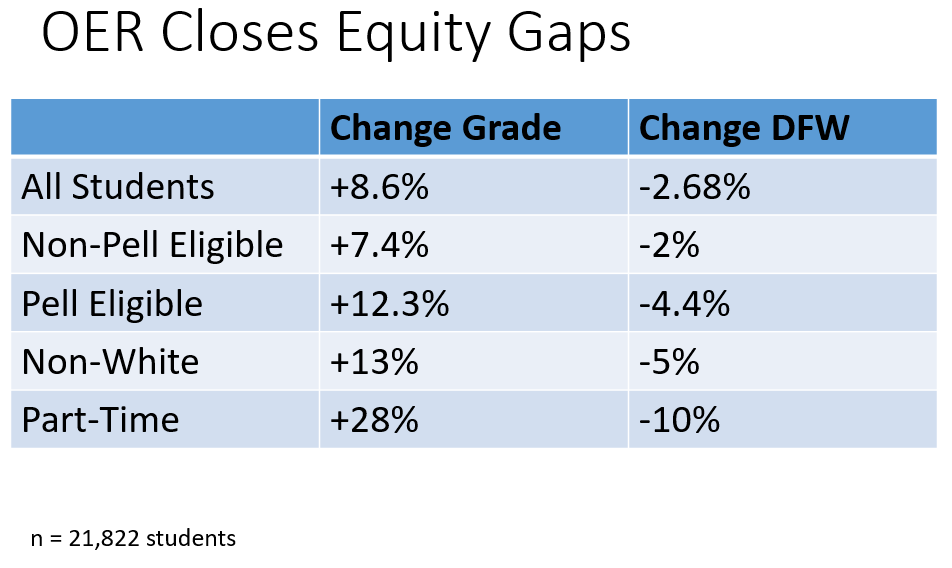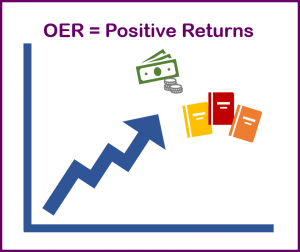Open Educational Resources in New York State
 By Jason Brown
By Jason Brown
The move to Open Educational Resources (OERs) has increased exponentially over the last few years with providers like Lumen, OpenStax and Saylor helping pave the way for the creation and distribution of OER materials. In that same time, several universities (Carnegie Mellon among them) began to embrace the development and use of OERs, initiatives like CCCOER (Community College Consortium for Open Educational Resources) launched, and helpful OER resources like Excelsior OWL were born. Individual universities, like the University of Georgia in 2017, “estimated that 35,985 students had been enrolled in a UGA course that had switched from an expensive textbook to a free textbook. It is further estimated that these students had collectively saved $3,266,930 as a result of this adoption” (Colvard, p. 264).
In addition, a few statewide university systems began encouraging the implementation of OERs at all of their campuses. CUNY (City University of New York) and SUNY (State University of New York) were among those university systems that promoted OERs across their combined 84 universities and colleges. Their endorsement of OERs continues presently and, as such, has even influenced the NYS budget in recent years where the state began, and continues to, allocate $8 million annually to “provide financial relief and give students the tools they need to succeed in college and beyond,” according to NYS Lieutenant Governor Kathy Hochul (New York). On the whole, NYS (in accounting for both SUNY and CUNY as of May 2018) has estimated the following gains from the adoption of OER materials:
- In the current academic year, OER has replaced textbooks in more than 4,000 course sections with enrollments totaling nearly 100,000 students, saving more than a combined total of $12.3 million.
- The second year of state funding will expand the reach of OER to nearly 8,000 additional course sections with enrollments totaling 175,000 students.
- By the end of the Spring 2019 semester, the initiative will have covered 260,000 students for a total savings of more than $28 million (New York).
While there seem to be many benefits of using OERs for reducing student expenses, the question remains whether they are making a difference in students’ lives educationally. After all, that is really the driving force behind any curricular changes worth their salt in academia. For that, one needs to turn to a recent article titled “The Impact of Open Educational Resources on Various Student Success Metrics” (Colvard et al.). The article outlines a 6 year study at the University of Georgia that compared “11,681 students…who were in courses using traditional commercial textbooks, and…10,141 students…who were in courses using free, OER textbooks” between Fall 2010 and Fall 2016 (Colvard, p. 266). All of those students in the survey were undergraduates who were enrolled in general education courses. The following illustrates the impact OERs had on student success in those courses that utilized them in lieu of traditional textbooks:

Fig. 1. This chart shows an average difference of 13.8% in A,B and C range grades and an average difference of -4.82% in D, F and W grades for students enrolled in courses that used OER texts when compared to those enrolled in non-OER courses (Colvard, p. 267-72).
As one can see in this study, the early returns academically are very positive when OER texts were used in classrooms both on campus and online. Anecdotally, my campus, Herkimer County Community College, has seen positive results as well. For those of us here, the process of OER adoption was first presented to us by the head of Instructional Design for Online Learning at our campus and representatives from Lumen in the fall of 2015. A presentation was scheduled for one of our “comeback” days, and, unbeknownst to those of us in attendance that day, my college had applied for (and already received) an Achieving the Dream grant. This meant we had to begin a move toward OER textbook adoptions in online (and several on campus) classes and even a few full degree programs (General Studies A.A. and Social Science A.A.). Beginning next fall, the latter is an initiative at my college that will guarantee matriculated students in those programs the ability to register for OER courses while fulfilling their degree requirements from start to the finish. It is being promoted more so for online students at present with the hope of including on campus students at a later point.

Furthermore, my campus has also encouraged faculty adoption of OERs by redistributing some of the money NYS allocated to CUNY and SUNY in its budget the last two years. Here at Herkimer, instructors who opted to use existing OER texts and/or create new OERs (for a period of 3 consecutive years) were paid an incentive. In short, once the $8 million from the state was split evenly between the CUNY and SUNY systems, those same entities then doled out an equal share (among 20 campuses in CUNY and 64 in SUNY) to each campus in their respective university systems. At my campus, we received roughly $62,500. Instead of reallocating the money toward other campus needs, administrators at my institute thought it wise to reward those of us who had already adopted (or were in the process of adopting) OERs in our courses. While it was not a windfall of cash for each instructor per se, it did motivate us to keep using OERs and I imagine piqued the interest of others who had not done so yet.
Given all of the positive returns OERs have provided financially and academically to date, I imagine this is why my campus took the initiative to embrace OERs a little over 3 years ago, why universities like the University of Georgia and state university systems like SUNY and CUNY have likewise supported the adoption of them and, more recently, the State of New York has gone so far as to fund OER development and adoption in recent budgets. Perhaps other states will follow suit where individual campuses can promote OER use, which can lead to university systems recognizing their overall worth and impact, which can lead to the state budgeting for further OER creation and use at their public universities.
Jason Brown is an Assistant Professor of English at Herkimer Community College, in Herkimer, NY. He is also a member of the OWL Advisory Board.
Works Cited
Colvard, Nicholas B., et al. “The Impact of Open Educational Resources on Various Student Success Metrics.” International Journal of Teaching and Learning in Higher Education, vol. 30, no. 2, 2018, pp. 262-76, www.isetl.org/ijtlhe/pdf/IJTLHE3386.pdf. Accessed 19 Sept. 2018.
New York State Government. “Governor Cuomo Announces $8 Million for Open Educational Resources Initiative at SUNY and CUNY to Cut High Cost of Textbooks.” Pressroom: Official News from the Office of the Governor, New York State, 16 May 2018, www.governor.ny.gov/news/governor-cuomo-announces-8-million-open-educational-resources-initiative-suny-and-cuny-cut-high.
